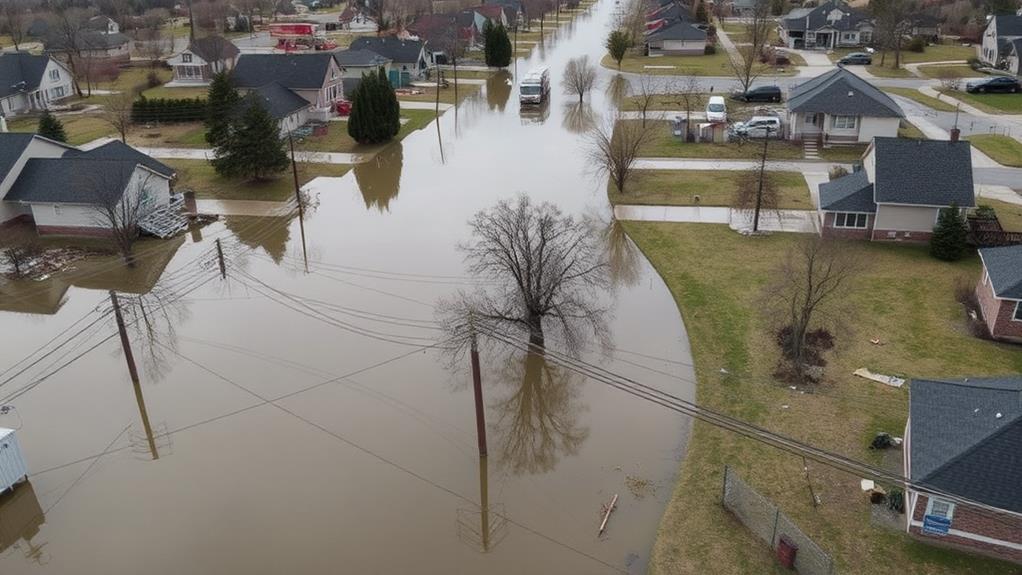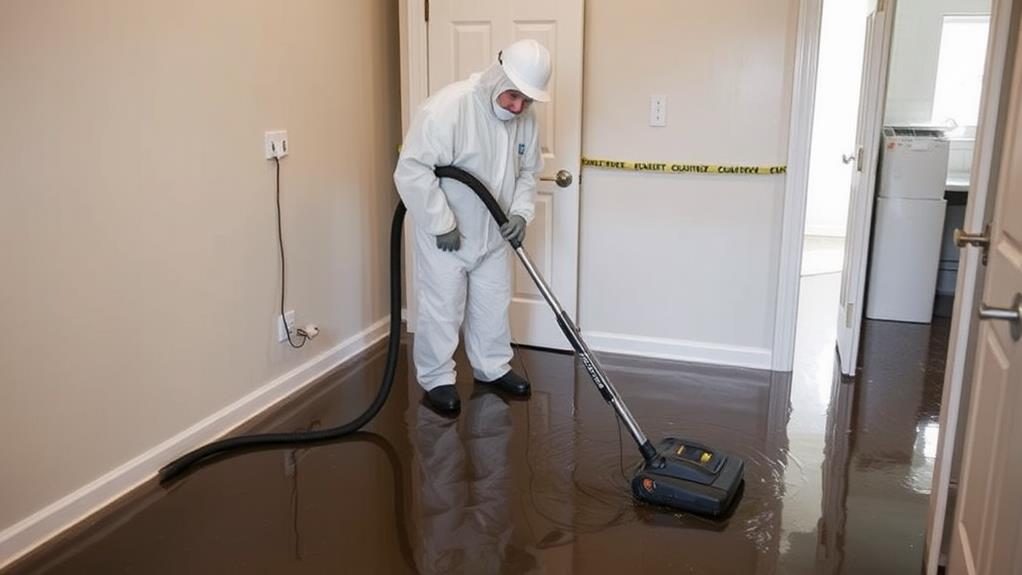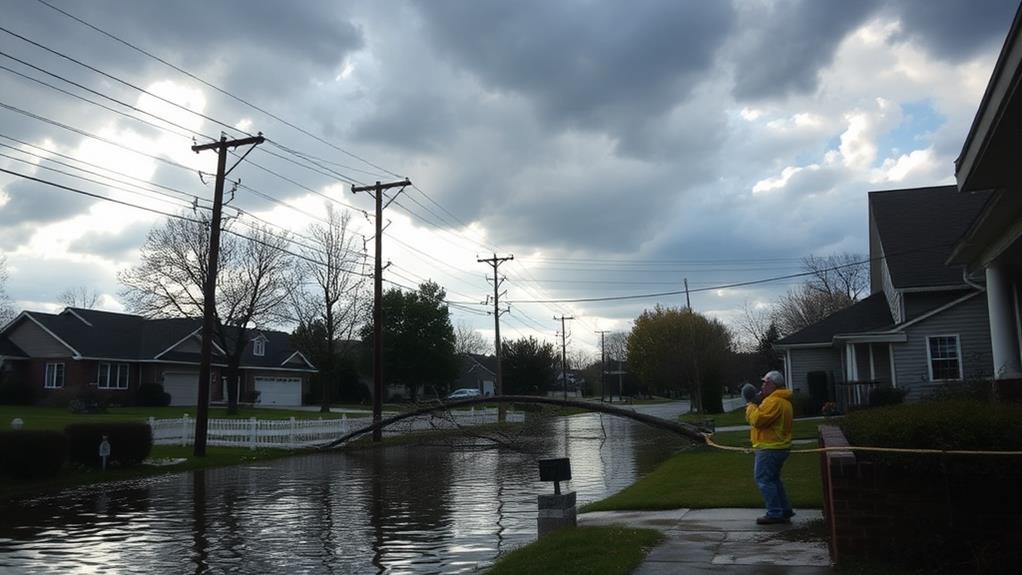Standing water after a storm creates severe electrical hazards that can be lethal. Water conducts electricity, making flooded areas extremely dangerous due to hidden risks like submerged power lines, damaged outlets, and electrified appliances. Before entering a flooded property, turn off the main power switch and wear protective gear like insulated rubber boots and gloves. Use a non-contact voltage tester to check for live currents. Avoid attempting to salvage flood-affected appliances, as they may be irreparably damaged. Always consult licensed professionals for electrical inspections and repairs. Proper understanding of these risks and safety measures can mean the difference between life and death in post-storm situations.
Understanding the Electrical Risks

When we consider the combination of standing water and electricity, we face a potentially lethal scenario. Water is an excellent conductor of electricity, and standing water after a storm can conceal various electrical hazards. These risks include downed power lines, submerged electrical outlets, and damaged electrical equipment.
The primary danger lies in the invisible nature of electricity in water. Even a small amount of current can cause severe injury or death. When a person comes into contact with electrified water, the current can flow through their body, potentially causing cardiac arrest, severe burns, or electrocution. The risk is heightened because standing water often contains contaminants that increase its conductivity.
It's crucial to understand that the danger extends beyond direct contact with visible electrical sources. Electricity can travel through water for considerable distances, creating a wide area of risk. Additionally, floodwaters can damage electrical systems within buildings, creating hazards that persist even after waters recede. Awareness of these risks is essential for anyone dealing with flood situations, as it underscores the importance of treating all standing water as potentially electrified until proven otherwise by qualified professionals.
Sources of Hidden Danger
Floodwaters conceal numerous electrical hazards that may not be immediately apparent to the untrained eye. Submerged power lines, both overhead and underground, pose significant risks. Even if a downed power line is not visibly sparking, it may still be energized and capable of transmitting electricity through water.
Fallen utility poles and damaged transformers can also create dangerous electrical currents in standing water.
Household appliances and electrical systems in flooded buildings present another source of hidden danger. Water-damaged electrical outlets, junction boxes, and circuit breakers may short-circuit or malfunction, creating shock hazards. Waterlogged appliances, such as refrigerators, washing machines, and water heaters, can become electrified and pose risks to anyone who comes into contact with them or the surrounding water.
Underground electrical infrastructure, including buried cables and utility vaults, may become exposed or damaged during flooding. These hidden electrical components can energize large areas of standing water, making it unsafe for wading or boat travel.
Additionally, backup generators and temporary power sources used during disaster recovery efforts can introduce new electrical hazards if not properly installed or maintained. Floodwater may also carry debris that can damage or disrupt electrical systems, creating unforeseen dangers.
Assessing Your Property

How can homeowners safely evaluate their property for electrical hazards after flooding? Begin by visually inspecting the exterior of your home from a safe distance, looking for downed power lines, damaged electrical meters, or exposed wiring. Never approach or touch these hazards. If you suspect any electrical issues, contact your utility company immediately.
Before entering your home, ensure the main power switch is turned off. If the basement or ground floor is flooded, do not attempt to access the main breaker yourself; instead, call an electrician.
Once inside, look for signs of water damage on walls, ceilings, and electrical outlets. Pay special attention to appliances that may have been submerged.
Use a non-contact voltage tester to check for live electrical current before touching any switches, outlets, or appliances. Be cautious of hidden electrical hazards in standing water, such as submerged extension cords or power strips. Document all damage for insurance purposes, taking photos when safe to do so. If you're unsure about any aspect of your electrical system's safety, consult a licensed electrician before attempting to restore power or use electrical devices.
Safety Gear and Equipment
Three essential pieces of safety gear are crucial when dealing with potential electrical hazards in flooded areas: insulated rubber boots, waterproof gloves, and a non-contact voltage tester. Insulated rubber boots provide protection against electrical currents that may be present in standing water, while waterproof gloves offer additional insulation for your hands when handling potentially electrified objects.
A non-contact voltage tester is invaluable for detecting live electrical currents without direct contact, allowing you to identify hazardous areas from a safe distance. Other important safety equipment includes a flashlight for navigating dark spaces, a first aid kit for emergency situations, and a fully charged mobile phone for communication.
Consider wearing protective eyewear to shield your eyes from debris or splashing water. A hard hat can protect against falling objects in damaged structures. For areas with potential gas leaks, a portable gas detector is essential. Always keep a supply of fresh batteries on hand for electronic devices. When working in flooded areas, use a life jacket or personal flotation device to prevent drowning. Remember, proper safety gear is your first line of defense against electrical hazards in flood-affected environments.
Proper Cleanup Procedures

Post-flood cleanup operations require a systematic approach to ensure safety and effectiveness. Begin by securing the area and ensuring all electrical power is disconnected. Wear appropriate personal protective equipment, including waterproof boots, gloves, and eye protection. Remove standing water using pumps, wet vacuums, or other suitable equipment.
Once the bulk of the water is removed, focus on thoroughly drying affected areas. Use fans, dehumidifiers, and open windows to promote air circulation. Remove wet carpets, furniture, and other porous materials that may harbor mold. Clean and disinfect all surfaces with a bleach solution or appropriate antimicrobial agents.
Document the damage for insurance purposes, taking photographs and keeping detailed records. Dispose of contaminated items properly, following local regulations for hazardous waste. Pay special attention to electrical systems, appliances, and wiring. Have a licensed electrician inspect and repair any water-damaged electrical components before restoring power.
Throughout the cleanup process, maintain vigilance for potential hazards such as structural damage, gas leaks, or contaminated water. If you encounter any dangerous situations, evacuate immediately and contact professional assistance.
Dealing With Flooded Appliances
Flooded appliances pose significant safety risks and often require replacement rather than repair. Water damage can compromise the electrical components and insulation of appliances, creating potential fire hazards and shock risks. Even if an appliance appears undamaged externally, internal corrosion and contamination may have occurred.
For safety, disconnect all flooded appliances from power sources immediately. Do not attempt to operate or test them until they have been professionally inspected. Large appliances such as refrigerators, washing machines, and dishwashers are particularly susceptible to flood damage and are usually not salvageable. Smaller appliances may sometimes be restored, but only after thorough cleaning and drying by a qualified technician.
When dealing with gas appliances, shut off the gas supply and have a licensed professional inspect them before use. Water heaters, furnaces, and boilers may need replacement if submerged. Electronics like televisions, computers, and stereos are rarely recoverable after flooding. Document all damaged appliances for insurance purposes, including photographs and serial numbers. Consult with your insurance provider regarding coverage for replacement costs. Prioritize safety over salvaging and err on the side of caution when deciding whether to keep or discard flood-affected appliances.
When to Call Professionals

Determining when to bring in professionals for flood-related electrical issues is crucial for safety and proper restoration. Experts should be called immediately if there's standing water near electrical systems, appliances, or outlets. Professional electricians are necessary when dealing with submerged electrical panels, circuit breakers, or wiring.
If you notice any signs of electrical damage, such as sparks, unusual odors, or discoloration around outlets, contact a licensed electrician promptly. Additionally, if your home experiences power outages or fluctuations after flooding, it's essential to have a professional assess the situation before attempting to restore power.
For severe flooding incidents, especially those involving sewage or contaminated water, specialized restoration companies should be consulted. These experts have the proper equipment and expertise to safely remove water, dry out affected areas, and prevent mold growth.
Always prioritize safety over attempting DIY repairs when it comes to electrical systems affected by flooding. Certified professionals can properly evaluate the extent of damage, ensure compliance with local codes, and provide documentation for insurance claims. Remember, electrical hazards may not always be visible, making professional assessment crucial for your safety and the integrity of your home's electrical system.
Long-Term Prevention Strategies
While addressing immediate electrical hazards is vital, implementing long-term prevention strategies can significantly reduce the risk of future water-related electrical issues. One effective approach is to elevate electrical systems and components above potential flood levels. This includes raising outlets, switches, circuit breakers, and wiring at least 12 inches above the base flood elevation.
Installing ground fault circuit interrupters (GFCIs) in areas prone to moisture exposure, such as basements, kitchens, and outdoor spaces, provides an additional layer of protection. Regularly inspecting and maintaining electrical systems, including checking for signs of corrosion or damage, can help identify potential problems before they become hazardous.
Proper drainage systems, including gutters, downspouts, and grading, can divert water away from buildings and electrical equipment. Consider waterproofing basement walls and floors to prevent water intrusion. For areas prone to frequent flooding, installing sump pumps with battery backups can help remove standing water quickly.
Developing an emergency preparedness plan that includes procedures for safely shutting off power during floods and guidelines for post-flood electrical inspections is crucial. Finally, staying informed about local flood risks and updating insurance policies to cover electrical damage can provide financial protection in case of water-related incidents.
Recovery and Restoration Tips

Safety should be the top priority when beginning the recovery and restoration process after water-related electrical incidents. Before entering any flood-affected area, ensure that the main power supply is disconnected. Wear appropriate personal protective equipment, including rubber boots and gloves, to minimize the risk of electric shock.
Begin by thoroughly inspecting all electrical systems and appliances for water damage. Any equipment that has been submerged should be considered unsafe and replaced. For less severe cases, consult a licensed electrician to assess the extent of damage and determine if repairs are possible. Document all damage for insurance purposes.
Remove standing water using pumps or wet vacuums, but only after confirming it's safe to do so. Employ industrial fans and dehumidifiers to dry out affected areas, preventing mold growth and further electrical complications. Clean and disinfect all surfaces that came into contact with floodwater.
Once the area is completely dry, have a qualified electrician inspect and test all electrical systems before restoring power. This includes checking wiring, outlets, circuit breakers, and ground fault circuit interrupters. Replace any damaged components and ensure all systems meet current safety standards before resuming normal operations.
Frequently Asked Questions
Can Standing Water Conduct Electricity From Downed Power Lines Nearby?
Yes, standing water can conduct electricity from nearby downed power lines. Water is an excellent conductor of electricity, making it extremely dangerous to approach or wade through standing water near fallen electrical infrastructure. Exercise extreme caution in such situations.
How Long Should I Wait Before Entering a Flooded Basement?
Time is of the essence, but safety comes first. Wait at least 24 hours before entering a flooded basement. Ensure power is off, water has receded, and professionals have inspected for structural and electrical hazards before venturing in.
Are Battery-Powered Devices Safe to Use in Standing Water?
Battery-powered devices are generally safer to use in standing water compared to mains-powered devices. However, it's still advisable to keep them dry and avoid submerging them. Always prioritize personal safety and follow manufacturer guidelines when using any electronic devices around water.
Can Fish Survive in Electrified Standing Water After a Storm?
Shockingly, 90% of fish can survive brief electrical exposure. Fish may initially survive in electrified standing water after a storm, but prolonged exposure can be fatal. Their survival depends on factors like voltage, duration, and species' resilience.
Does Adding Salt to Standing Water Increase Its Electrical Conductivity?
Yes, adding salt to standing water significantly increases its electrical conductivity. Dissolved salt ions allow for greater movement of electrical charge through the water. This principle is widely applied in various scientific and industrial applications involving electrolytes.
Conclusion
In the aftermath of storms, vigilance regarding electrical hazards and standing water is paramount. Like a hidden minefield, dangers may lurk beneath seemingly innocuous puddles. Proper assessment, safety gear, and cautious cleanup procedures are essential. When in doubt, professional assistance should be sought. By implementing long-term prevention strategies and following recovery tips, property owners can navigate the treacherous waters of post-storm cleanup, ensuring safety and facilitating efficient restoration of affected areas.

